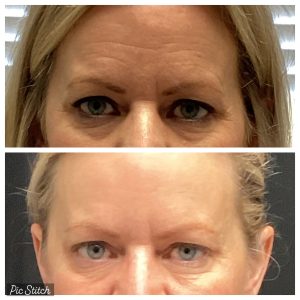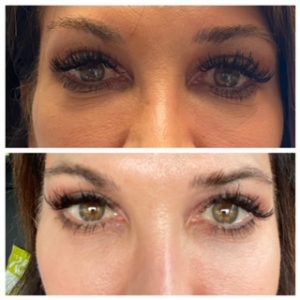Deciding Between Dermal Fillers vs. Botox in Rochester, MI
Which Skincare Treatment is Ideal for Your Needs?
Looking to rejuvenate your appearance? You’ve likely encountered two popular options: dermal fillers and Botox. Both skin health treatments offer effective yet distinct solutions, and understanding their differences is crucial for making informed choices. Let’s delve into each treatment, exploring its benefits, candidacy factors, and how they work.
When you’re ready to achieve your ideal skin appearance, call Front Door Medspa in Rochester, MI, today at 248-BESTSPA (237-8772).
What are Dermal Fillers?
Dermal fillers are injectable substances that act as architects beneath the skin, adding volume and definition to specific areas of the face. They come in various forms, each offering distinct properties and benefits. Some, like hyaluronic acid, a naturally occurring substance in our bodies, attract and retain moisture for instant hydration and plumping.
Others, like calcium hydroxylapatite, stimulate the body’s natural collagen production over time, providing long-lasting results for deeper wrinkles and volume loss. Regardless of the specific type, dermal fillers offer a range of benefits to address various concerns.
Benefits of Dermal Fillers

- Sculpting and Defining Facial Contours: Dermal fillers can be strategically placed to add volume and definition, restoring youthful fullness and reshaping facial contours for a more sculpted and balanced look.
- Plumping and Enhancing Lips: Fillers can be used to add volume and shape to the lips, enhancing their appearance and creating a more defined and balanced look. This can boost confidence and contribute to a more youthful overall aesthetic.
- Smoothing Out Scars: Certain types of dermal fillers can be used to fill in the indented areas, smoothing out the scar tissue and improving its appearance. This can result in a more even and visually pleasing skin texture.
- Hydrating and Improving Skin Quality: Not all fillers work solely by adding volume. Some, like hyaluronic acid fillers, also possess the ability to attract and retain moisture within the skin.
Candidacy for Dermal Fillers
While dermal fillers offer a multitude of benefits, they are not a one-size-fits-all solution. It’s crucial to assess your suitability before committing to the procedure. Here are some factors to consider:
- Medical History: Openly discuss any pre-existing medical conditions or allergies you may have with your healthcare professional. These factors can influence the suitability of certain filler types.
- Age: While individuals of any age can consider fillers, addressing concerns early in the aging process can be advantageous. Early intervention can help prevent deeper wrinkles and volume loss, potentially leading to longer-lasting results.
- Desired Outcome: Be upfront about your aesthetic goals and expectations during your consultation. This allows your healthcare professional to assess your needs and recommend the most appropriate filler type and placement strategy.
- Realistic Expectations: Remember, dermal fillers offer effective rejuvenation but are not permanent. Maintaining results may require touch-up sessions over time.
How Do Dermal Fillers Work?
Dermal fillers work in various ways, depending on the specific type used. Here’s a simplified breakdown:
- Volume Replacement: Fillers like hyaluronic acid and calcium hydroxylapatite act like tiny scaffolds, directly filling in lines and wrinkles, providing immediate volume, and smoothing the skin’s surface.
- Hydration: Specific fillers, like hyaluronic acid, boast the unique ability to attract and retain water molecules. This hydrates the skin, plumping it up and improving its texture and elasticity.
- Collagen Stimulation: Certain fillers, like poly-L-lactic acid, work by stimulating the body’s natural collagen production over time. This leads to long-term volume restoration and improved skin quality.
What is Botox?
Botox is not a filler but rather a brand name for a purified protein called botulinum toxin. Unlike fillers that add volume, Botox works by temporarily relaxing the muscles responsible for facial expressions. This relaxation smoothes out dynamic wrinkles, those that appear when you frown, squint, or smile.
Benefits of Botox

-
- Smoothing Dynamic Wrinkles: As mentioned, Botox excels at addressing wrinkles caused by repeated muscle contractions. This includes crow’s feet around the eyes, frown lines between the brows, and forehead lines.
- Treating Chronic Migraines: Studies have shown Botox to be an effective treatment option for chronic migraines, significantly reducing their frequency and severity.
- Managing Excessive Sweating (Hyperhidrosis): Botox injections can be used to effectively treat excessive sweating in areas like the underarms, palms, and soles of the feet.
- Treating Muscle Spasms: Botox can be used to address muscle spasms caused by neurological conditions like cervical dystonia (causing involuntary neck movements) and blepharospasm (causing involuntary blinking).
- Treating Teeth Grinding (Bruxism): Botox can also help treat nighttime teeth grinding, also known as bruxism. This condition can damage teeth and lead to TMD, but Botox helps relax the jaw muscles to aid in preventing teeth grinding.
- Gummy Smile: A gummy smile is when a large portion of gum tissue shows when you smile. Botox injections in the muscles that control the upper lip can help limit how much the lip lifts, reducing the amount of gum shown.
- Lip Flip: A lip flip uses a small amount of Botox injected into the border of the upper lip to create a slight outward curl, making lips appear fuller.
- Neck Bands: Neck bands are those vertical lines that can form on the neck. Botox injections relax the muscles that contribute to these lines, creating a smoother appearance.
- Wide Jaw: In some cases, Botox can be injected into the masseter muscle, which is the muscle responsible for chewing. Relaxing this muscle can help slim the appearance of a wide jawline.
Candidacy for Botox
Similar to dermal fillers, Botox isn’t suitable for everyone. Here are some key factors to consider:
- Medical History: Disclose any pre-existing medical conditions or medications you’re taking to your healthcare professional. These factors can influence the suitability of Botox treatment.
- Pregnancy and Breastfeeding: Botox is not recommended for pregnant or breastfeeding individuals.
- Realistic Expectations: Understand that Botox results are temporary, typically lasting three to six months, and require touch-up sessions to maintain the effects.
How Does Botox Work?
Botox treatments work by:
- Blocks Nerve Signals: Botox injects a purified protein that temporarily blocks the signals sent from nerves to specific muscles.
- Muscle Relaxation: Unable to receive signals, the targeted muscles relax and are unable to contract.
- Smooth Wrinkles: As these muscles relax, the overlying skin smooths out, reducing the appearance of dynamic wrinkles caused by facial expressions.
- Temporary Results: The effects of Botox are temporary, typically lasting three to six months, due to the body naturally breaking down the protein over time.
Determining Which Treatment Best Suits Your Needs

Wrinkle Type:
One main thing to consider when choosing between these two are the types of wrinkles they can correct:
- Dynamic Wrinkles: Caused by facial expressions and appear when you frown, squint, or smile. Botox excels at addressing these wrinkles by relaxing the underlying muscles.
- Static Wrinkles: Present even at rest and appear as lines or folds. Dermal fillers effectively address these wrinkles by adding volume and smoothing out the skin’s surface.
Additional Considerations
Other factors to consider include:
- Cost: Both treatments typically require touch-up sessions to maintain results. Fillers can be slightly more expensive due to the varying amounts needed and the number of treatment areas.
- Longevity: Fillers generally last longer than Botox, with effects lasting from six months to two years depending on the type used and the treated area. Botox results typically last three to six months.
- Side Effects: Both procedures are minimally invasive and have well-established safety profiles. However, temporary side effects like swelling, bruising, and redness can occur.
Visit Front Door Medspa for Comfortable Skincare Treatments
Ultimately, the best way to determine which option is right for you is to consult with a qualified medical professional at our med spa. We can provide a personalized assessment, discuss your goals, and recommend the most suitable treatment plan to achieve your desired results.
Call 248-BESTSPA (237-8772) to schedule a consultation at Front Door Medspa today.
Get Directions

